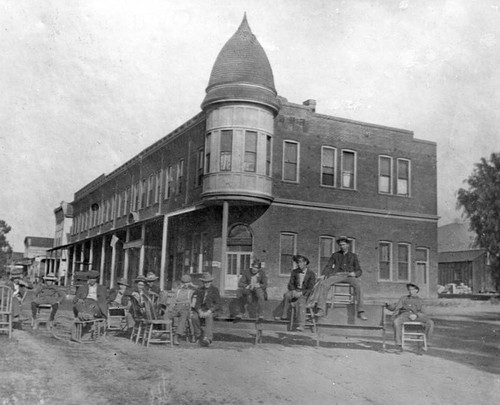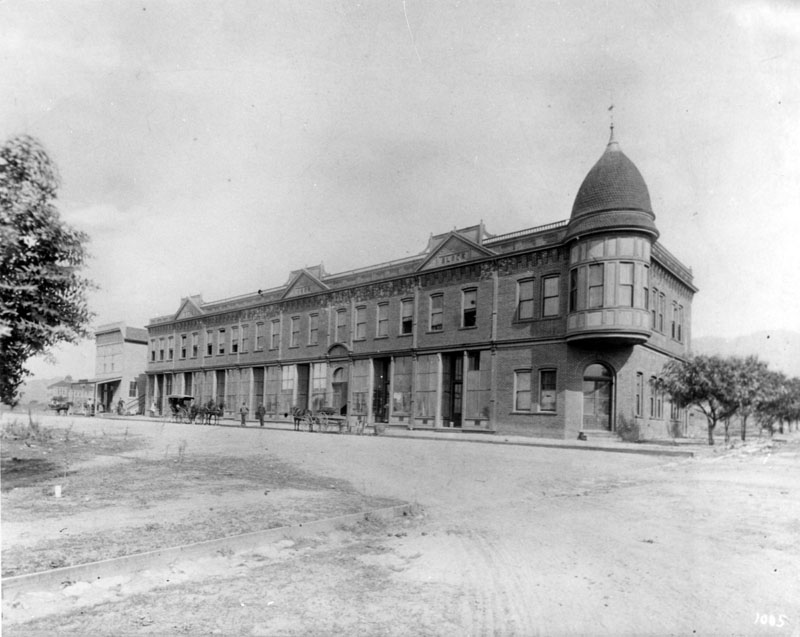In the 1980s I had my first office in the first brick building in Burbank, built at San Fernando Road and Olive in 1888, pictured here. In fact, I was there for the building’s centennial (which no one celebrated because no one know about it then).
By the time I was installed, it had changed quite a bit. The parapet was gone in an earthquake many decades ago, and the bottom part was now a series of independent businesses, food establishments and the sort.
The upper offices were really cool. Heavy oak doors with transoms and patterned plate glass in them. Much like the feel of a seedy private detective in the 1940s or a railroad office in the old west.
I had found the office because my college friends from film school, Chris Huntley and Stephen M Greenfield had set up their new company there, Screenplay Systems, where they developed and marketed the world’s first screenplay formatting software called Scriptor (for which they both later won a Technical Achievement Award from the Academy (you know, the Oscars).
I recall driving by the building several times on my way home from an editing job in Hollywood and seeing the light on in their office, with Steve visible in the window, cranking out the code for Scriptor on the Z-80 computer he had built himself from a Heathkit.
Steve had previously been the director of photography on the first feature length film I directed called The Strangeness, which you can see even today on Amazon Prime – though none of us get any residuals from it.
Chris was my co-producer and co-writer (along with Mark Sawicki, the first friend I made at USC). Chris, Steve, and Mark were roommates at the time we made The Strangeness, I believe, though I don’t remember if Chris had moved out yet.
I do know that we shot a few of the special effects shots for The Strangeness there at the house in Burbank they were renting together.
One shot was designed to look like a horizontal mine tunnel and a huge ball of fire was supposed to rush down it toward our heroes. Mark and Chris did this by creating a miniature of the tunnel about 2 x 2 feet and ten feet long, and placed it vertically.
At the bottom, they placed a film can filled with hot melted paraffin, then lit the fumes above it on fire, like a flambe. Mark had a camera secured at the top behind a sheet of plexiglass. He’d climb up a ladder, start the camera to shoot extra fast to create slow motion when played at normal speed.
As soon as the camera started, Chris would throw a glass of water on the flaming paraffin and it would explode in a fireball when the steam vaporized and would shoot twenty feet into the air, right past the camera.
We did several takes, at night of course (for best effect) and late so no one would be watching, since we were pretty sure it was illegal. Sure enough, after every explosion, we’d hear the beating of a police helicopter which would fly nearby looking for whoever was creating these fireballs.
But the flash only lasted a couple seconds so we’d just freeze in place with the lights off until it flew away and then set off the next one. Two minutes later they’d be back again, and we played cat and mouse like this for about an hour until we got all the shots we needed. Fortunately, they never got a fix on us.
The shot turned out great in the movie, by the way, though if you look closely you can see the “rock” walls shudder a bit because they were actually made of industrial thickness aluminum fail, crinkled to look like rock, then spray painted appropriately with dirt thrown on the wet paint to complete the look.
Another effects shot we did there was of a second miniature tunnel where we did stop motion photography of our tentacled monster in the mine.
All the tentacles had to be slightly moved and then one frame shot then moved again, then another frame, and so on. At 24 frames per second, it not only took a lot of time, it was also very complex to keep each of the many tentacles twisting and curling in the right directions. And on top of this, Mark added an animated camera movement down the tunnel during the stop-motion by repositioning the camera slightly after each adjustment to the miniature monster!
I even animated one of the monster shots myself just for the fun of it.
Anyway, Mark and I were the only crew on this, though I think a shot or two was done by Mark’s semi-famous animator friend, Ernie Farino at another time.
This day, we needed to create some fog on the miniature set, but couldn’t use a fog machine because the animation would make the swirls of fog jumpy and ruin the effect.
After much discussion, Mark remembered he had an orange rescue flare from his uncle’s boat. So, just before we started animating, he set it off in the closed garage where we had our miniature.
In short order, the place was filled with an acrid, lung-burning, orange smoke, but it did create the effect we were looking for – a nice even fog.
So, for an hour or thereabouts we hung out in that space, shooting animation frame by frame, then darting out the side door for a quick breath of fresh air before diving in once again.
In the end, we got the shot and it was really good! But, when I got home, I discovered my white underwear had turned orange. Mark told me later that week he had sneezed up orange snot for three days.
I wondered what that might do to my health. Now, forty year later, so far so good. But, to quote John Milius (director of the original Conan The Barbarian film), “Pain in temporary; film is forever.”
That’s a pretty good place to end this memory thread. Later, I’ll start from that same office building and tell you tales of creating my first album of original music there, bringing my kids there after school so I could continue working while I watched them (and the adventures we had), the true to life Mystery of Geppetto The Mole, and many more stories from the building officially known (when it was built) as The Burbank Block.
“Until next time, this is Gary Owens and Morgul, the Friendly Drelb.”
(Google it)

